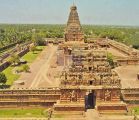THE FATHER OF INDUISM AND HIS SERVICES FOR THE RENAISSANCE OF INDUISM
His Holiness Siddhar Kaaviriyaatrangarai Karuwooraar functioned as the Father of Induism. His masterpiece in architectural construction is the Big Temple of Thanjavur.

He constructed it as the Head Quarters of His planning and scheming forum of the Renaissance Movement, namely the 'Arutpani Virivaakka Thittam'. It was the head office for the Indu Renaissance Movement or the Indu Religious, Socio-political party ('Indu Marumalarchy Iyakkam') and the Liberation Movement of Tamil Race, Language & Literature and Tamils' Religion ('தமிழ் இன மொழி மத விடுதலை இயக்கம்').
He started this in the year 785 A.D. He built the Big Temple using the Royal family He created.
He was very particular in using His Big Temple as the University Office of the International Multifarious University ('பன்னாட்டுப் பல்நோக்குப் பல்கலைக் கழகம்').
He assumed the responsibilities of the Supreme Judge. So the place where He lived, i.e. the Big Temple was the Supreme Court for the nation.
The Big Temple was also used as the Theatre, Art Gallery and Auditorium for selecting the best artists in all types of arts, music, dance, drama, sculptre, etc. As He was the Master of all arts and sciences, He used the Big Temple for giving proper recognition and due respects to the artists and certified them depending on their performance.
His Holiness evolved methods to utilise the abilities of the artists for cultural revolution; In this way, He uplifted the artists and improved the cultural standard of the Tamil Society during His period. His Holiness used to invite and encourage various artists to have a cultural meet at the Big Temple. The artists came from various coutries and from abroad also.
He built the Big Temple in a broad area of 144 acres having a fort protected by a deep moat. Surrounding the Big Temple, the city was developed in a circular oval shape having a radius of 2 miles. Surrounding this city there was another fort wall protected by another deep moat.
This Thanjavur city was further fortified by five deep rivers which were used as deep moats for fortifying the great city Thanjavur. The Thiruvaiyaaru Temple was inside the seventh fortress. Within His lifetime, His Holiness could not complete the construction of the outer five fort walls. Only the rivers gave protection to the City. Thus the Aiyaarappar Temple of Thiruvaiyaaru remained as the Gateway for Thanjavur, the city of Seven Walls and Seven Moats.
Within the Big Temple of Thanjavur there were a number of buildings to run Colleges, Training Centres for Sciences, Arts, Engineering, Technical Studies, Martial Arts, Warfares, Fine Arts, Divine Sciences, Languages and Literatures and so on. Most of the curricular activities were fully residential. The students came from many different parts of the world.
His Holiness was the Chancellor of the University. This alone earned a very good name and fame from all over the world. All the royals, nobles, chieftains and feudals were trained and educated in this University. From Himalayaas to Cape Comorin students were enrolled in this University.
So, the City Thanjavur remained as the City of Knowledge and Education, City of Philosophers and Theologians, City of Artists and Scientists, City of Functions and Festivals, City of Gaiety and Enjoyment. This He achieved by making Thanjavur as the City where great scholars and heroes having true and sincere pattriotism resided. And it helped Raja Raja Chola I to a great extent to expand the Indu Divine Empire to overseas nations beyond Tamilnadu.
The RajaRaja Chola I had a strong naval force, trained by His Holiness who founded the Later Chola Empire, the City of Thanjavur and the Big Temple of Thanjavur. But His Holiness could not complete the construction of the City on account of the misunderstanding between Him and the Chola Emperor RajaRaja Chola I.
After the period of His Holiness (1040 A.D.), Karuwoor Thevar the only son of Him held the post of Chancellor upto 1182 A.D. After 1182 A.D. the Chola Emperors themselves remained as Chancellors till 1272 A.D. After that, the Chancellors and Vice-Chancellors were selected from the Religious Mutts of Madurai, Thirunelveli, Thiruchendore, Thiruvannamalai, Chidhambaram, Kumbakonam, Thenkasi and so on.
NOTE: This International University of Thanjavur was the University of Tamils. During Pallava period, Kanchipuram was the centre for studies through Sanskrit language. There was not much importance for Tamils there. So, His Holiness founded this University of Thanjavur for studies through Tamil. There was a branch of Kanchi Mutt at Kumbakonam. His Holiness ordered to remove this Mutt because it worked for Sanskrit. [There is a separate article about Dharmapuram, Thiruppanandhal and other Saiva Mutts.]
